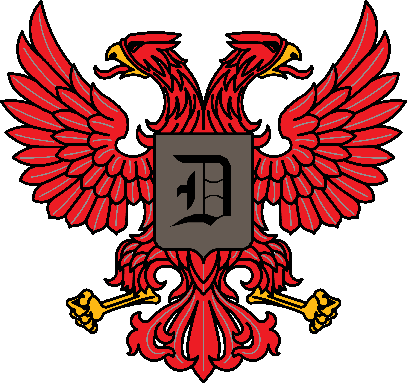

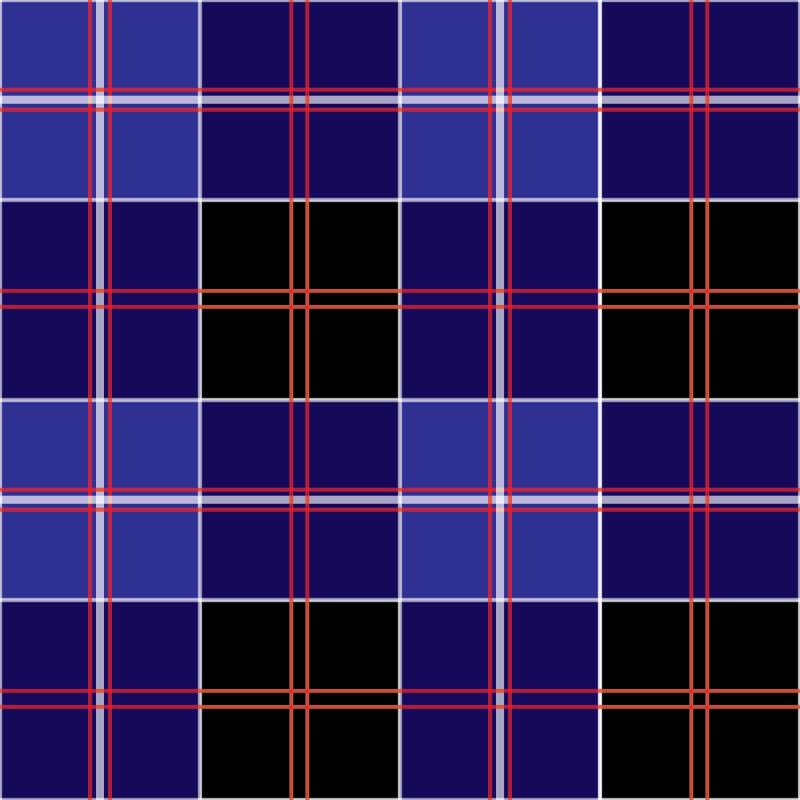
![]()
History of Tartan

Tartans have become synonymous with Scotland and Scottish clans and families in particular. However, tartans were originally a style of cloth intended to be decorative. They had patterns that were popular within certain districts of manufacture, they relied on a limited range of colour dyes and were made of the local coarser type of wool.
This has lead to the idea of district tartans being the original association, between the land, the community and its cloth. Where there was a strong clan within a district, as was often the case in the highlands, then visitors from other areas might well have been recognised as of a clan from their tartan. This must have been true of visitors from the Western Isles, for instance. It is this concept of clan tartans that today predominates, but the use of tartan is yet richer.
When tartan was proscribed by law, the Government or Black Watch pattern was the only legally one. This was used by the regiments raised within Scotland, forming the basis of the regimental tartans.
By the early 1800s, it was realised that the knowledge of tartans before the ´45 was being lost and, simultaneously, there was a romantic movement concerning Scotland's past. This lead to institutional and individual efforts to preserve tartan designs. Tartans were reconstructed from portraits, collected on pilgrimages, demanded from clan chiefs and recovered from weaver's notes.
Tartans became a backdrop. The weaving and tailoring industries were especially boosted by the visit to Edinburgh of George IV in 1822 and by Sir Walter Scott's statement, as the visit's manager, "Let every man wear his tartan". Queen Victoria gave considerable encouragement thereafter, though this encouraged both fantasy and fact in the study of tartan. (Some royal tartans remain the preserve of the House of Windsor or individual titles within it, just as clan chiefs sometimes have a chief's tartan.)
The significance of tartan as national dress, worn under various circumstances, created clan tartans for every "name", even those that previously had none. These were often supplemented by hunting tartans of subdued character and dress tartans which were brighter.
Further variety was added by fashion, fancy or trade tartans to fill any niche, including various colours of a single pattern. Dancing Tartans originate from the ARISAID or Dress Tartans. There were even some mourning tartans developed.
In recent years the corporate tartans have become popular where an institution or company adopts a tartan design for livery and use in merchandising.
Where no clan tartan exists, families can and have (As we did) developed new Family Tartans. Generally which tartan is worn is controlled by convention there not being a statute for its government. Disputes as to its use and production rely on the civil law of Copyright, Design Act and in rare cases Patents/Trademarks. Most tartans are registered with the World tartan registry or the Scottish Tartan Society to ensure their uniqueness.
Manufacturers often offer a given tartan design in a variety of colour effects, called Modern, Reproduction, Ancient and the like. An ancient and a modern tartan is often the same pattern and should not be confused when the design is being considered.
From the Scotland.Net
![]()
"The history of tartan is as old as the Scots people themselves dating back to the 5th century when they arrived from Ireland with their "woollen cloth of different colours", and it remains as it began as a symbol of clan and national identity.
However, in its original form, a rough woollen cloth worn as a plaid, tartan had a highly practical function of providing warmth and shelter from the harsh Scottish weather. Over the years, the plaid became modified into the kilt which was in fairly common use along side the plaid by 1795.
Tartan has fallen in and out of favour as the popularity of the Scots and all things Scottish has grown and waned. In 1747, shortly after the Jacobite rebellion, the Dress Act forbade the wearing of tartan with offenders receiving a punishment of six months imprisonment or transportation. Scotsmen were made to swear an oath pledging their compliance with the law:
"I do swear... as I shall swear to God at the great day of judgement, that I have not, nor shall l have in my possession, any gun, sword, pistol, or arm whatsoever, and never use any tartan, plaid, or any piece of highland garb."
Once the law had been repealed, tartan reappeared slowly, mainly as a military uniform, and it was not until George IV's visit to Scotland in 1822 that it was in vogue once more. In Queen Victoria's day, fashion added new checks, decorative sporrans, and skean dhu's, and these were formally incorporated into our present idea of highland dress.
Over the years, each clan or family has developed its own distinctive "sett" distinguished by the number of threads of each colour in the pattern. Nowadays, tartan has virtually lost its function as a hardwearing cloth for hunting and working purposes, and the more traditional and sombre colours, based on vegetable dyes, have been replaced by dress tartans with their brighter overchecks. To many Scotsmen and women tartan is emblematic of something heroic and indefinable, and they continue to wear it with pride. "
from the Scottish Tartan Society
![]()
The Modern STS#1197
The Hunting STS#1205
The Dress STS#1784
and the Ancient.
![]()
![]()
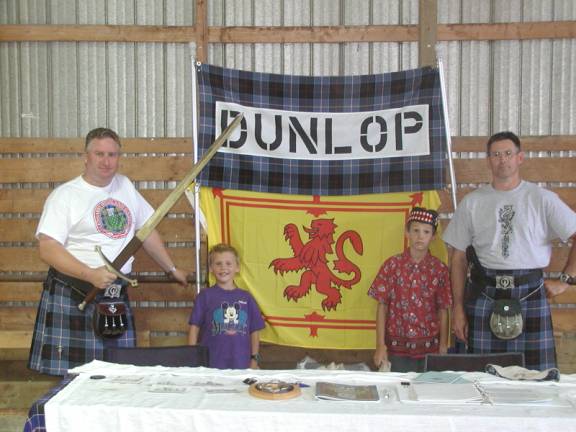
Ancient
"Ancient" is a tartan term which describes the coloring as if
being done with ancient dye techniques. These colors would then look "faded or
not as coloured" as with modern dyes. Ancient tartans are popular because they
look olde. David and Blair Dunlop of Canada wear the Ancient Dunlop proudly.
![]()
See the online store at Things Scottish for Dunlop and Dunlap items
many of you have asked where to get Dunlop tartan...below are a few sources....remember the difference between single wide and double wide (56') and the weight (either in oz or twill...larger # is thicker wool)
Get Modern and Ancient Dunlop at Heritage of Scotland in many packages.
John Morrison Kiltmakers
63 High Street EH1 1SR Edinburgh, Scotland
Get Dunlop Modern and Ancient by the yard at Linda Clifford Scottish Merchant
10
- 11.5 oz Double-Width -$59/yd.
13 oz. Double-Width -$65/yd.
13 oz. Old & Rare Double-Width - $85/yd.
16 oz. Double-Width - $75/yd.
16 oz. Single-Width -$65/yd.
Get Dunlop Modern in many products at
House of Tartan ( $57/yd Medium 335)
Click here to download a Dunlop tartan desktop theme
![]()

History of Dunlop Tartan
Richard Dunlop, of Washington, DC, the second President of our Society, started a journey on April 2, 1974 that culminated in the creation of our Family Tartan.
That day Richard wrote a letter to
the Mayor of Dunlop asking if there was any tartan, family or clan, associated
with the surname of Dunlop and where he may obtain a picture, description, or
the material itself. The response was to write to the Lord Lyon, King of
Arms in Edinburgh. After a lot of research and a few years later he connected
with Elsie Harnish, the founder and first President of the Dunlop/Dunlap Family
Society.
The Society had been started in
the Summer of 1979 with Elsie and her son in Pennsylvania, and one member each
in Florida, Alabama, South Carolina, Ohio (Reverend John Hanna) and New Jersey.
Richard soon joined forces with Elsie and this alliance created the foundation
of the Society.
Elsie had written to The Scottish
Tartans Society regarding a tartan and on July 18, 1980 received a response from
Thomas H. Jones, North American representative of the STS. Thomas advised her to
do the following: Have a tartan designed by a tartan weaver. Use an existing
tartan that has some link or significance to the Dunlop’s and change a line or
two, or a color. Register the tartan with the STS, since there are over (at that
time) 1300 different tartans. By registering we would ensure that no one else is
using that design, and also that no one else would ever use ours. He also
suggested a weaver, the Ferris Wheel in Bethesda, Maryland. Thomas did state
that if Elsie pulled this off within a year, it would be very fast!
Correspondence from the Ferris
Wheel on Sept 4, 1980 from Thomas Ferris suggested that Elsie contact J. Charles
Thompson of Arlington, Virginia, a leading authority on tartans. This gentleman
would keep them on the right path. It turns out that J Charles Thompson is the
Chairman of the committee on Heraldry of the Council of Scottish Clan
Associations (COSCA). He was instrumental in helping Elsie design the Dunlop
badge. He did direct her in November 1980 to the Lord Lyon Court in
Edinburgh. He wanted her to ask if there was a chief of Dunlop, what his arms
may be, to determine the crest for the Badge design, which Elsie wanted to wear
with the tartan once they had found or designed one. Elsie is now where Richard
was six years ago! They needed to go to Lord Lyon.
On May 4th, 1981, now
vice-convener Richard Dunlop wrote the Lord Lyon Office in Edinburgh. He
announced the formation of the Dunlop/Dunlap Society. He requested their
assistance, in the interest on conforming to the rules of heraldry, in the
design of a crest, if none existed. He asked for the name, crest, and location
of the last chief of Dunlop. After giving them a short history of the Dunlop
origins, he told them of the impending creation of a Dunlop tartan and the
desire to submit it for approval. Richard then followed this up with a letter on
May 6th, 1981, giving more history of possible chieftain lineage and
the problem of two crests. One showed the dirk held “proper” and one “with bend
sinister” (the Kirk window).
The long awaited reply came on May
27th, 1981 from Elizabeth Bruce, Secretary to the Lord Lyon, Court of
the Lord Lyon, Edinburgh, Scotland. Ms Bruce stated “that the latest Arms were
recorded in 1838 (Vol.4, fol.31) in the Public Register of all Arms and Bearings
in Scotland for Sir John Dunlop of Dunlop, Baronet. It appeared to her that no
one had made up title to these Arms since that time. The Arms did hold the
dagger “erect all proper” which would be the correct way for the crest to
portray. She did consult with “the Dunlops of Dunlop: of Auchenskaith, Keppoch
and Gairbraid” by JG Dunlop, privately published by Butler and Tanner 1939. She
relayed that Mr. Dunlop states that the headship of the Family lay with Roy Neil
Wallace Dunlop, son of Arthur Wallace Dunlop, second son of John Andrew Dunlop
and Elizabeth Sandwith. Roy was born in December 1922 and it is likely that he
is still alive. If in fact he were living in the States, he would not be barred
from being a Clan Chief. As regards to the Tartan, it is the normal practice of
this court only to record in the Lyon Court Books (Writs section) the thread
counts of tartans when the petition is by the chief of the Name. “ Richard now
had some direction.
Richard wrote to the Scottish Tartans Society on May 21rst, 1981. He gave them some history of the now two-year-old Society and told them of the desire to design a tartan of our own. He told them that we could currently wear the Cunningham, since Dunlops intermarried with, fought alongside and were imprisoned with the Cunningham’s, as well as living in that district. He relayed that the Society had decided to use the Cunningham tartan, differentiating it by changing one of the two principal colors (red to blue). He had discussed this with
. Charles Thompson, and determined it to be acceptable. What does the Family
need to do from this point? Can we register a tartan? What must we do to get the
above described approved and registered? Is there a charge? Would there be any
restrictions on us holding this tartan out as that of those bearing our surnames
to be worn anywhere, including Scotland itself? He then gave them a thread count
for the proposed tartan.
The STS wrote back on June 26th,
1981. Dr. Michel MacDonald replied that the Scottish tartans Society maintains
the Register of all known tartans and acts as the research unit for the
Monitoring Committee for Scottish tartans. That body is made up of
Representatives of the Lord Lyon, Standing Council of Scottish Chiefs, the
National Museum of Antiquities, and various representatives of the tartan
weavers and sellers trade. There is a search fee to determine if the requested
pattern already exists, a design fee of 100 pounds to design, etc. Dr. MacDonald
saw no obstacle for the Society to Register a tartan, and there would be no
restrictions regarding wearing of that tartan! The thread count would be
sufficient to start the process and soon the Dunlop tartan would be on its way!
Well, Richard will be laughing as
he reads this, because he had to write and wait and change and write again at
least ten times to the weaver, Mr. Dalgliesh, of DC Dalgliesh Ltd. Selkirk,
Scotland. They discussed the shade of Blue, which eventually had to be created
as a “Dunlop Blue”. He also conferred with Peter Eslea MacDonald, F.S.A. Scot of
the STS regarding design and Thread count, which after many changes and some
errors (which ended up better than the original and then were adopted!) were
finalized in March 1982!
After many frantic letters and
samples, the finalized version arrived in time for the July 1982 Grandfather
Mountain Highland Games, where the Dunlop tartan was announced to over 30,000
people who viewed it for the first time ever, as a kilt and a banner. It was a
fitting time for the tartan’s debut, since 1982 was the 200th
anniversary of the lifting of the ban on highland dress, under pain of death!
By November 1984, after again many
changes and letters to the STS and the weavers, the Hunting and Dress tartans
were approved and delivered. Ten years and seven months later,
Richard’s question of where he could find the Dunlop tartans was finally
answered.
I have had the opportunity to read
all of these correspondences that Richard has saved for posterity. To describe
all of the details involved regarding thread counts, line and sett changes,
colors, designs, and the two burstingly full notebooks of letters would fill ten
newsletters! It is directly because of his incredible perseverance, patience and
determination (with input and support from Elsie) that we have the beautiful
‘Black’n’Blue’ and the other tartans that we wear today.
Thank you, Richard, from all of
us!
![]()

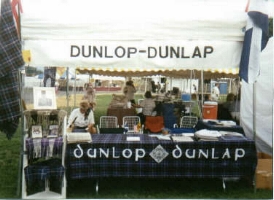
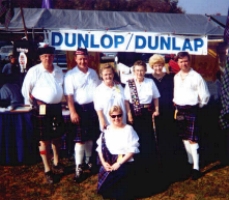
" Dunlops/Dunlaps wearing the 'Black 'n Blue' Modern "
